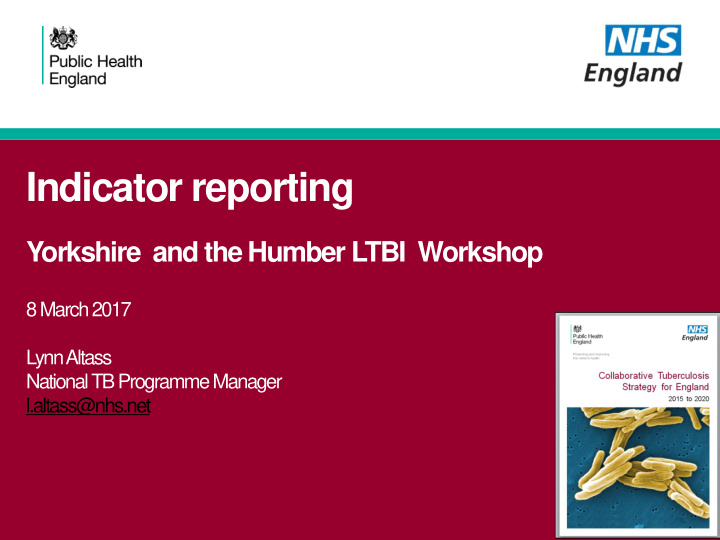



Indicator reporting Yorkshire and the Humber LTBI Workshop 8 March 2017 Lynn Altass National TB Programme Manager l.altass@nhs.net
Why do we need indicators? • Programme progress • Programme evaluation • Commissioning • Contracting and monitoring i.e. NHSE assurance process • Ad hoc reports 2
Who needs the information? • CCGs • PHE • NHSE • TB Control Boards 3
National TB Programme reporting structure PHE National Executive NHS England National Executive PHE Delivery Board NHSE TB Strategy Co-ordination Group National TB Programme Board Co-chaired by PHE and NHS England TB Strategy ‘areas for action’ TB Delivery Board ‘task and finish’ groups Chaired by Head of National TB Office TBCB TB leads and managers network Yorkshire & Humber East Midlands East of England London NW England South of England TBCB West Midlands and North East TBCB TBCB TBCB TBCB TBCB (SE & SW PHE Centres) TBCB (Y&H and NE PHE Centres ) - TB networks (numbers will vary) TBCB - TB Control Board 4
What indicator systems are there? • LTBI programme • Fingertips • Infographics • TB Strategy progress measures • NHSE data systems i.e. Flag4, CCG and NHS provider activity • NICE quality standards Collaborative TB Strategy & TB in under-served populations – Feb 2017
LTBI testing and treatment programme There are four types of information required/collected for the LTBI testing and treatment programme: • LTBI testing and treatment activity – primary care and secondary care data collection systems • LTBI test analysis laboratories activity reports – local and national • PHE LTBI database – 48 variables, most of which are routine • LTBI programme – six national indicators The number of CCGs that have a new entrant LTBI testing and treatment programme in place Proportion of eligible new entrants covered by LTBI testing programmes who accept LTBI testing The proportion of positive, negative and indeterminate tests The proportion of patients who take up treatment amongst those who have been offered it Proportion of individuals who complete LTBI treatment amongst those who start treatment The proportion of patients who experience significant drug events amongst those who initiated treatment 6
LTBI test analysis laboratories KPIs • Blood sample to be with the testing laboratory within timeframes that meet the time cut-off parameters of the relevant test used, • Test result to be available to the test requestor/patient’s GP within five working days of blood sample being taken, including electronic reporting where this is available • Test results to also be available to relevant treatment services in order to enable continuity of care of the patient i.e. specialist TB services. • An audit to be taken of avoidable indeterminates, with the results and actions taken to be supplied to NHS England and the relevant CCG. Samples found to be indeterminate will be rerun at least once using the remainder of the blood sample using appropriate test methodology • Performance within applicable UKNEQAS schemes 7
Fingertips - TB Collaborative TB Strategy & TB in under-served populations – Feb 2017
Infographics 9
TB Strategy progress measures – why? • Do we have the data/information we need to show the progress of the strategy? • Standardisation of data/information provision to ensure appropriate services are provided • ‘Like for like’ comparisons at national and local level • Developed to validate the 10 ‘areas for action’ • Using current data systems and evidence based feedback progress measures provide NHSE and PHE with information on the epidemiology and control of TB pre strategy and post TB strategy • To demonstrate that nationally and locally (TB Control Boards) have a robust LTBI programme in place • Provide progress reports for NHSE and PHE • Using information provided by: the PHE FES teams using the outputs of Cohort Review National and London TB surveillance systems - ETS, LTBR NHSE i.e. CCGs, hospital activity, laboratory data Collaborative TB Strategy & TB in under-served populations – Feb 2017
Progress measures • 10 ‘areas for action’ • Each ‘area for action’ has three or four detailed actions supporting development and implementation of the ‘area fro action’ • Each detailed action has a ‘progress measure definition’ which can be measured objectively or which objective information is available • The data source is defined • Comments can be made • Example below a) LTBI testing and treatment 8.1 Priority CCGs LTBI programmes Yes/No NHSE programmes are in place for priority implemented yes/no CCGs A8 Systematically implement new entrant latent TB (LTBI) screening b) LTBI testing and treatment programmes are monitored and reported 8.2 PHE able to provide activity reports on Yes/No PHE on LTBI programmes yes/no 11
Recommend
More recommend